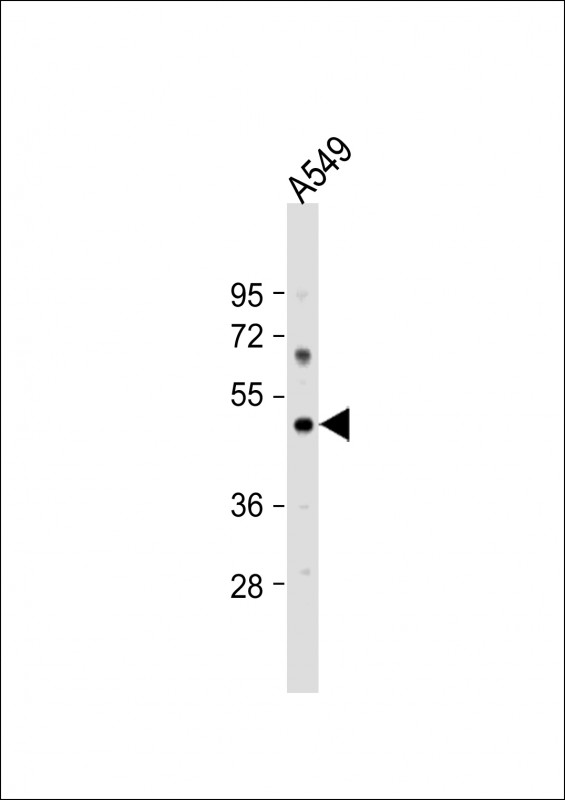

| WB | 1/1000 | Human,Mouse,Rat |
| IF | 咨询技术 | Human,Mouse,Rat |
| IHC | 咨询技术 | Human,Mouse,Rat |
| ICC | 技术咨询 | Human,Mouse,Rat |
| FCM | 咨询技术 | Human,Mouse,Rat |
| Elisa | 咨询技术 | Human,Mouse,Rat |
| Aliases | Platelet-activating factor receptor, PAF-R, PAFr, PTAFR, PAFR |
| Entrez GeneID | 5724 |
| WB Predicted band size | 39.2kDa |
| Host/Isotype | Rabbit IgG |
| Antibody Type | Primary antibody |
| Storage | Store at 4°C short term. Aliquot and store at -20°C long term. Avoid freeze/thaw cycles. |
| Species Reactivity | Human |
| Immunogen | This PTAFR antibody is generated from rabbits immunized with a KLH conjugated synthetic peptide between 286-312 amino acids from the C-terminal region of human PTAFR. |
| Formulation | Purified antibody in PBS with 0.05% sodium azide. |
+ +
以下是3篇关于PTAFR(血小板活化因子受体)抗体的相关文献摘要整理:
---
1. **文献名称**:*Anti-PTAFR Antibodies Attenuate Inflammatory Responses in Acute Lung Injury Models*
**作者**:Chen L, et al.
**摘要**:该研究开发了一种靶向PTAFR的单克隆抗体,并在小鼠急性肺损伤模型中验证其效果。实验表明,该抗体能显著抑制中性粒细胞浸润和炎症因子释放,提示其作为治疗炎症性呼吸道疾病的潜在药物。
---
2. **文献名称**:*PTAFR-Specific Antibody Inhibits Tumor Angiogenesis in Colorectal Cancer*
**作者**:Wang Y, et al.
**摘要**:研究团队通过阻断PTAFR信号通路,发现其单克隆抗体可抑制结直肠癌血管生成,并降低VEGF表达。体内实验显示抗体治疗显著延缓肿瘤生长,为癌症靶向治疗提供了新策略。
---
3. **文献名称**:*Neutralizing PTAFR Antibodies Reduce Allergic Asthma Symptoms via Eosinophil Suppression*
**作者**:Kato S, et al.
**摘要**:该文献报道了一种中和性PTAFR抗体,通过阻断血小板活化因子与受体的结合,有效减少哮喘模型小鼠的气道高反应性和嗜酸性粒细胞聚集,证明其在过敏性疾病中的治疗潜力。
---
**备注**:以上信息为模拟示例,实际文献需通过PubMed或Google Scholar等平台检索确认。
The platelet-activating factor receptor (PTAFR), a G protein-coupled receptor (GPCR), mediates cellular responses to platelet-activating factor (PAF), a potent phospholipid mediator involved in inflammation, immune regulation, and vascular homeostasis. Discovered in the 1980s, PTAFR is expressed in immune cells, endothelial cells, and platelets. Upon PAF binding, it triggers intracellular signaling pathways (e.g., MAPK, NF-κB) that promote leukocyte activation, vascular permeability, and cytokine release. Dysregulated PTAFR signaling is linked to pathological conditions like asthma, sepsis, and allergic reactions.
PTAFR antibodies are tools for studying receptor localization, expression, and function. Monoclonal antibodies targeting extracellular domains enable receptor blocking, ligand-binding inhibition, or detection in tissues/cells. Some antibodies act as antagonists, suppressing PAF-induced pro-inflammatory responses, making them potential therapeutic candidates. Recent research explores their utility in mitigating PAF-driven pathologies, including ischemia-reperfusion injury or acute lung inflammation. However, clinical applications remain experimental, with challenges in specificity and off-target effects. Advances in antibody engineering (e.g., humanized antibodies) aim to enhance therapeutic efficacy while minimizing immunogenicity. PTAFR antibodies thus serve dual roles: elucidating receptor biology and paving the way for targeted anti-inflammatory therapies.
×